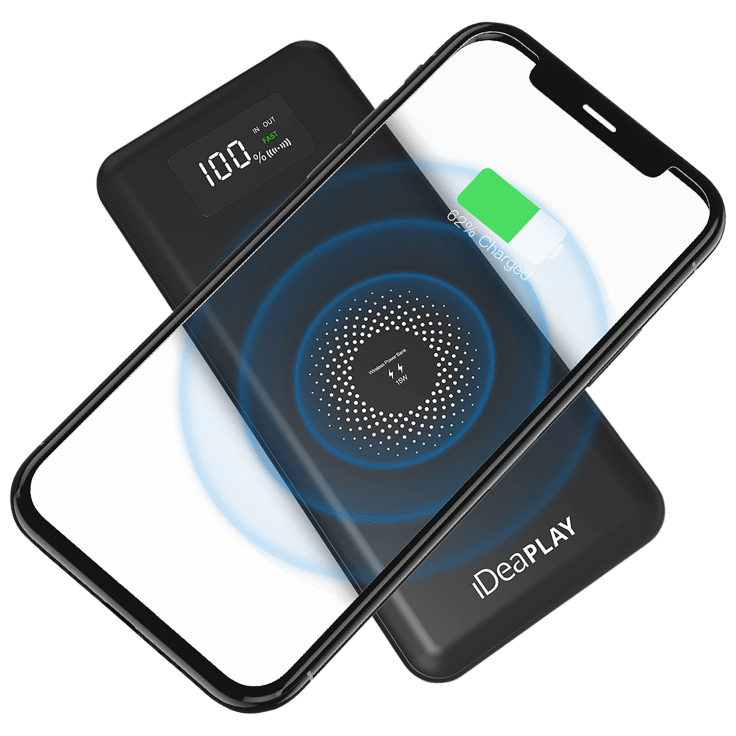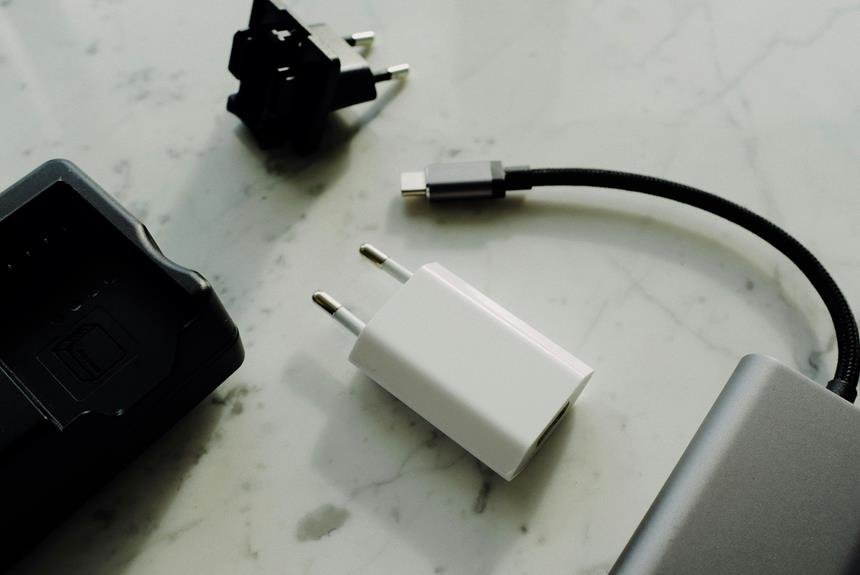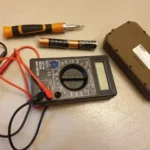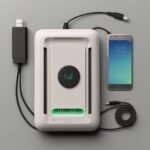To charge your Ideaplay Power Bank, first identify the suitable input port—often micro-USB or USB Type-C. Match it with a compatible charging cable. Use a dependable adapter, ensuring voltage compatibility for safe charging. Connect the cable securely from the adapter to the power bank. Monitor the LED indicators: a blinking blue LED signifies active charging while a solid blue indicates full battery. Unplug once fully charged to avoid overcharging. Follow these precautions for best performance. For a deeper insight into maintaining battery health and troubleshooting, you can continue exploring further details.

Unboxing Your Power Bank
Upon unboxing your Ideaplay Power Bank, you’ll find the device itself, a user manual, and a charging cable neatly packed inside. The packaging details are minimal yet efficient, ensuring you get everything you need right out of the box. The power bank’s sleek design and compact form factor make it highly portable, perfect for those who value freedom and mobility.
Let’s explore the power bank features. The Ideaplay Power Bank boasts a high-capacity battery, allowing multiple device charges on a single power cycle. It’s equipped with advanced safety mechanisms to prevent overcharging, overheating, and short-circuiting, ensuring both your devices and the power bank remain protected. The device also includes LED indicators that show the remaining battery life, so you’re always informed about its power status.
Additionally, its lightweight construction doesn’t compromise on durability, making it a reliable companion for your travels. The user manual provides straightforward instructions for best use, helping you get the most out of your power bank. With these features at your disposal, you can enjoy the freedom of staying powered up wherever you go, without worrying about running out of battery.
Identifying the Ports
To efficiently utilize your Ideaplay Power Bank, you’ll need to identify its various ports. Start by examining the edges of the power bank. Typically, you’ll find different port locations marked clearly for ease of access. Look for input and output labels on the device. The input port is where you’ll connect your charging cable to power up the bank itself, while the output ports are used to charge your devices.
Most Ideaplay Power Banks come equipped with multiple types of ports. You might see a micro-USB input, a USB Type-C input/output, and several USB-A output ports. Each port type serves a specific function and supports different cable compatibility. For instance, a USB Type-C port is versatile and can handle both input and output, making it a preferred choice for modern devices.
Understanding these port locations and their purposes ensures you make the most of your power bank’s capabilities. This knowledge is essential for efficient charging and top-notch performance. Always match your cables correctly to the ports to avoid any charging issues or potential damage to your devices. By identifying these ports accurately, you’ll maximize your Ideaplay Power Bank’s efficiency.
Choosing the Right Cable
Selecting the appropriate cable for your Ideaplay Power Bank is essential for ensuring efficient and safe charging. First, verify the cable compatibility to make sure it matches the input port of your power bank. Typically, Ideaplay Power Banks use either a Micro USB, USB-C, or Lightning cable. Refer to your power bank’s specifications to confirm which type you need.
Next, consider the power output. Using a cable that supports higher power output can reduce charging time significantly. For example, if your power bank supports fast charging, you’ll need a cable rated for higher amperage, such as 2A or 3A. Many standard cables only support up to 1A, which will charge your device much slower.
Make sure the cable is certified and of high quality. Poor-quality cables may not handle the power output efficiently and can pose safety risks, such as overheating or short-circuiting. Look for cables with reinforced connections and shielding to guarantee durability and performance.
Lastly, avoid excessively long cables as they can result in power loss and reduced charging efficiency. A cable length of 3 feet is generally sufficient for most charging needs while maintaining optimal power transfer.
Connecting to a Power Source
To connect your Ideaplay power bank to a power source, first, select a compatible charging adapter that matches the power bank’s input specifications. Next, insert one end of the charging cable into the adapter and the other end into the power bank. Verify a secure connection to start charging efficiently.
Choosing Charging Adapter
When selecting a charging adapter for your Ideaplay Power Bank, make sure it aligns with the power input specifications listed in the user manual. Voltage compatibility is essential to guarantee safe and efficient charging. Check the voltage and current ratings required by your power bank. Using an adapter with the wrong specifications can harm your device or reduce its lifespan.
You have several adapter options. A standard USB wall adapter will suffice for regular charging. However, if you’re looking for fast charging capabilities, opt for an adapter that supports higher wattage and is compatible with fast charging protocols. This will considerably reduce the time it takes to charge your power bank.
Safety precautions are necessary when choosing an adapter. Ensure that the adapter you’re using is certified by relevant safety standards, such as UL or CE. This certification indicates that the adapter has been tested for safety and reliability. Avoid using inexpensive, uncertified adapters, as they may pose risks like overheating or short-circuiting.
Plugging in Cable
After selecting the appropriate charging adapter, you’re ready to connect your Ideaplay Power Bank to a power source using a suitable cable. To start, identify the correct port on your power bank—often a micro-USB or USB-C. Plug one end of your charging cable into this port and the other end into your chosen adapter.
For effective cable management, make sure your cables are untangled and free from damage. This helps in maintaining a neat workspace and extends the life of your cables. Here’s a quick reference table for common ports and cables:
| Device Port | Cable Type | Adapter Port |
|---|---|---|
| Micro-USB | Micro-USB | USB-A |
| USB-C | USB-C | USB-C |
| Lightning | Lightning | USB-A or USB-C |
| USB-A | USB-A to USB-C | Wall Adapter |
| USB-C | USB-C to USB-A | Wall Adapter |
While charging, practice good charging etiquette. Avoid overloading power strips and make sure your power bank is placed on a flat, stable surface. This prevents any potential hazards and promotes efficient charging.
Monitoring LED Indicators
To effectively monitor your Ideaplay Power Bank, pay close attention to the LED indicators. These LEDs provide important information about charging status, battery levels, and color meanings. Understanding these signals guarantees you always know your power bank’s condition.
LED Color Meanings
Understanding the LED color indicators on your Ideaplay Power Bank is vital for effectively monitoring its charging status and battery level. The LEDs provide quick visual cues about the power bank’s current state, helping you avoid common issues and ensuring your device is always ready when you need it.
Typically, a solid blue LED means your power bank is fully charged and ready for use. If the LED is blinking blue, it’s actively charging. A red LED, on the other hand, often indicates that the battery level is low and needs recharging soon. Yellow or amber LEDs can signal various states, often related to intermediate charge levels or specific conditions outlined in your user manual.
For effective troubleshooting tips, always refer to the instructions provided with your Ideaplay Power Bank. If you encounter an unresponsive LED or an unexpected color, consult the user manual for guidance on resolving the issue. Understanding these LED indicators is crucial for maintaining the health and functionality of your power bank, allowing you the freedom to stay powered up without unnecessary interruptions. Keep these details in mind, and you’ll master the art of managing your Ideaplay Power Bank efficiently.
Charging Status Indicators
Monitoring the LED indicators on your Ideaplay Power Bank offers real-time insights into its charging status and battery health. When you connect your power bank to a power source, observe the LED lights to guarantee proper operation. A steady LED light typically indicates ongoing charging, while a flashing light might indicate an issue.
For charging safety, always use the recommended cables and chargers. Avoid overcharging by unplugging the power bank once the LED shows it’s fully charged. If the LEDs don’t behave as expected, here are some troubleshooting tips: First, try a different charging cable or adapter. Common issues often stem from faulty cables. If the LEDs still don’t light up, inspect the charging port for debris or damage.
Precautions are essential to maintain your power bank’s longevity. Avoid exposing it to extreme temperatures, both hot and cold. If you notice unusual warmth while charging, disconnect immediately to prevent potential hazards. Regularly checking the LED indicators not only guarantees your device is charging correctly but also keeps you informed about its overall health.
Battery Level Signals
Keep an eye on the LED indicators to quickly gauge your Ideaplay Power Bank’s remaining battery level. Each LED light represents a specific percentage of the battery capacity, usually in 25% increments. For instance, if all four LEDs are lit, your power bank is fully charged. If only one LED is on, it means the battery is nearly empty and needs recharging.
To monitor the battery level, press the power button once. The LED indicators will light up, showing you the current charge status. This feature is essential for managing your power needs and planning when to recharge. Remember, using the power bank at lower battery levels may affect the charging speed of connected devices.
When recharging the power bank itself, the LED indicators will blink, indicating the charging progress. As the battery capacity increases, more LEDs will stay lit continuously. Once all LEDs are solid, your Ideaplay Power Bank is fully charged and ready for use.
Charging Time Estimates
To estimate the charging time for your Ideaplay power bank, consider its capacity and the output power of the charger you’re using. The charging speed is a critical factor. Typically, the output power of your charger, measured in watts (W), will influence how fast your power bank charges. For example, a 10,000mAh battery capacity with a 5W charger will take longer than one charged with a 10W charger.
To calculate the estimated charging time, use this formula: Charging Time (hours) = Battery Capacity (mAh) / Charger Output (mA). For instance, a 10,000mAh power bank with a charger output of 2,000mA (equivalent to 10W) will need about 5 hours to fully charge.
Tips for Optimal Battery Life
Ensuring your Ideaplay power bank lasts as long as possible involves a few key practices that can greatly extend its battery life. First, focus on proper battery maintenance and mindful power consumption. Regularly check the battery level and avoid letting it drop to 0% too frequently. Keeping it between 20% and 80% can greatly prolong its lifespan.
Here are some essential tips:
- Charging Habits: Don’t overcharge. Unplug the power bank once it reaches 100%. Continuous charging can overheat the battery, leading to premature wear.
- Storage Tips: Store your power bank in a cool, dry place. Avoid exposing it to extreme temperatures, as both high heat and cold can diminish battery performance.
- Regular Use: Use the power bank frequently. If you don’t use it often, make sure to charge it at least once every three months to maintain the best battery health.
Frequently Asked Questions
Can I Use My Ideaplay Power Bank While It’s Charging?
You can use your Ideaplay power bank while it’s charging, but it’s not advisable. Using while charging may affect charging safety and efficiency. For best performance and safety, it’s ideal to charge it uninterrupted.
Is It Safe to Leave My Power Bank Plugged in Overnight?
Leaving your power bank plugged in overnight isn’t recommended. It can impact battery longevity and introduces overcharging risks. For best performance, unplug it once fully charged. This guarantees your device remains efficient and reliable longer.
How Do I Know if My Power Bank Is Fully Charged?
You’ll know your power bank is fully charged by observing the power bank indicators. Typically, all indicator lights turn solid. Charging time varies, check the manual for specifics. Enjoy the freedom of a fully charged device!
What Should I Do if My Power Bank Isn’t Charging?
If your power bank’s a stubborn gatekeeper, start with troubleshooting steps: check cables, ports, and power sources. Explore alternative charging methods. If it’s still unyielding, consider replacement options or warranty claims. Freedom’s in your hands.
Can I Charge Multiple Devices Simultaneously With My Ideaplay Power Bank?
Yes, you can charge multiple devices simultaneously with your Ideaplay power bank. Verify device compatibility options are met. Keep in mind, charging speed might vary depending on the number of devices and their individual power requirements.



